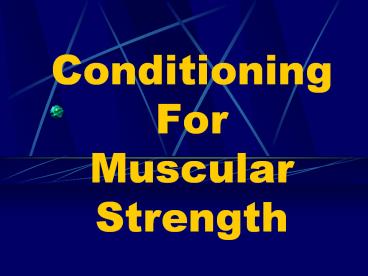Conditioning For Muscular Strength - PowerPoint PPT Presentation
1 / 27
Title:
Conditioning For Muscular Strength
Description:
Conditioning For Muscular Strength Overload Principle Work muscle above and beyond what it is accustomed to and it will adapt ! Overload may be an increase ... – PowerPoint PPT presentation
Number of Views:30
Avg rating:3.0/5.0
Title: Conditioning For Muscular Strength
1
Conditioning For Muscular Strength
2
Overload Principle
- Work muscle above and beyond what it is
accustomed to and it will adapt ! - Overload may be an increase
- Resistance
- Repetitions / Sets
- Contraction velocity
3
Adaptation and Specificity
- Muscles adapt differently based on the type of
overload placed on them. - Specify the training regimen to elicit the
desired adaptations.
4
Specificity of Training
- Training should overload the system / muscle
type that the individual wishes to train! - IE Energy systems, muscle fiber type, and sport
specificity.
5
Muscle Fiber Types
- Fast Twitch (FG / Type II)
- ? anaerobic capacity
- Type IIa (FOG) vs. IIb
- Fatigue easily
- Fast contractile velocity (Vmax)
6
Muscle Fiber Types
- Slow Twitch (SO / Type I)
- Vmax ½ Vmax of FG fibers
- ? Mitochondria Density
- ? Aerobic Enzymes
7
Muscle Fiber Types and Performance
- Genetics
- Specificity of Training
- Fiber Conversion
- Power Force X Velocity
8
Types of Contractions
- Concentric Muscle shortens w/ contraction
- Eccentric Muscle lengthens while it is
contracted. - Static (Isometric) No change in muscle length w/
contraction
9
Types of Training
- Isotonic Movement of a set resistance through a
ROM - Isokinetic Speed of contraction is controlled
while subject exerts max effort - Isometric Training using static contractions
10
Fatigue
- Muscular fatigue is caused by decreases in pH
brought about by buildup of lactic acid. - LA builds up due to lack of O2 to buffer H ions
resulting from glycolysis. These H combine with
pyruvate to form LA.
11
(No Transcript)
12
DOMS
- Delayed Onset Muscle Soreness
- Caused by
- Minute tears in muscle tissue
- Acute inflammation
- Alteration in cells Calcium regulation
- Osmotic pressure changes (retention of fluid)
- Muscle spasms
- Any combination of the above
13
Adaptations to Strength Training
- Neural Adaptations (First 8-12 weeks)
- Learn Movement (Motor Learning)
- ? Coordination
- ? Motor Unit Recruitment
- ? Coordination of Motor Unit
- Neuromuscular inhibition (GTO , Muscle Spindles)
14
Muscular Adaptations
- Muscle Fibers (Physical Changes)
- Increase in Size Hypertrophy (Particularly Type
II) - Directly proportional to the VOLUME of overload
- Volume Resistance X Repetitions
- Increase in Number Hyperplasia (?)
15
Muscle Fiber Conversion?
- Studies are inconclusive???
- Most show no change or very little
- Appears that IIb ? IIa w/ intense aerobic
training - Largely genetic and relatively stable (Absolute
Number)
16
Energy System Adaptations
- ATP CP
- Will increase stores of ATP-CP
- Anaerobic Glycolysis
- ? in levels of glycolytic enzymes
- Less LA produced, more efficient Cori cycle, ? LA
tolerance
17
Gains in the Beginning of a Program
Steroids
8-12 Weeks
Strength
Steroids
Hypertrophy
Progress
Neural Adaptations
Training Duration
18
Other Adaptations
- Intramuscular Fuel Stores
- ATP, CP, and Glycogen Increase
- VO2max
- Depends on training
- Connective Tissue
- Ligament / Tendon Strength Increases
- Increase in connective tissue surrounding muscle
fibers? Increased bulk - ? Bone Mineral Density
19
Other Adaptations
- Capillary Density
- Decreases w/ intense, high intensity ST
- No Change w/ circuit or low weight, high
repetition ST - Mitochondrial Density
- Decreases due to ? CSA
- Glycolytic Enzymes
- Increase
20
Other Adaptations
- Hormonal Changes
- Acute increase in Epinephrine, Norepinephrine,
and Cortisol (? Gluconeogenesis) - Cholesterol
- ? Total Cholesterol
- ? HDL-Cholesterol
- (Results have been somewhat inconclusive)
21
Specificity of Training
- Aerobic Training
- IIb ? IIa
- Hypertrophy of I and IIb fibers
- Increase in enzymes, mitochondria, capillaries
especially in I (SO) fibers
22
Specificity of Training
- Strength / Power Training
- Hypertrophy of IIb Fibers
- ? glycolytic enzymes
- ? LA tolerance
- ? in of CSA from type II
- Increased contraction velocity?
23
Strength
- Strength is a function of
- Neural Factors
- Type of fibers engaged
- Anthropometrics/Biomechanics
- Size of Muscle (CSA)
24
Frequency Systems
- Split Routine
- Upper / Lower Body
- Alternate Day
- Total body w/ 48 hrs. rest
- Antagonist Split Routine
- Agonist / Antagonist muscle on opposing days.
25
Lifting Systems
- Percentage
- Circuit
- Pyramid (Progressive Resistance)
- Super Set
- Maximum Fatigue (Negatives)
26
Recommendations
- WARM UP / COOL DOWN !
- Start with large muscle / multi-joint exercise
and progress to single-joint / isolation
exercises - Overload Core muscles last
27
Recommendations
- ALWAYS allow 48 hours for complete recovery !
- Start slow !
- NEVER overload a sore muscle !































